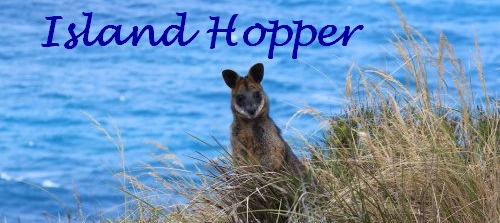| Back to Back Issues Page |
 |
|
Island Hopper, Issue #053,, Shearwater Update April 20, 2021 |
April 2021: Issue #053 Hello, Welcome to Island Hopper! I hope you will discover lots about Phillip Island and the surrounding area.
Shearwater UpdateThe fledgling shearwaters are preparing to begin their journey to the Arctic Circle.Please read this update from Phillip Island Nature Parks to find out how we can help them on this amazing migration.
"Phillip Island Nature Parks is asking for community support as Short-tailed Shearwater chicks begin emerging from their burrows to leave our shores and undertake their incredible migration to waters around Alaska. Phillip Island Nature Parks researchers confirm that the adult birds have already taken off on their journey, leaving one chick in each burrow, converting their fat reserves to muscles in readiness to take their first flight across one of the most amazing flight paths in nature. Some of these first-time flyers have been starting to exercise their wing muscles in the recent strong winds, with a few being blown over the cliffs and onto the island’s beaches. Nature Parks’ rangers are conducting regular patrols to relocate these chicks back into the colony so they can try again when the winds are right. In a recent visit to the colony, the research team reported evidence of a successful breeding season. “In summary, we found record high numbers of chicks which are in healthy condition and good body weights nearly ready to fledge,” said Phillip Island Nature Parks Deputy Research Director, Dr Duncan Sutherland. The team reported that most chicks still had their down feathers and were spending most of their time in their burrows to grow their adult plumage before venturing out on the first test flights. “It looks like only a few of the chicks are emerging from their burrow to exercise their wing muscles at the moment and that will change soon.” The exact timing of this year’s migration of the young shearwaters is still unknown but will coincide with strong winds towards the end of April, start of May. Whenever it happens, Phillip Island Nature Parks is ready to go with its Shearwater Rescue Program, once again partnering with Bass Coast Shire Council, Regional Roads Victoria, SP Ausnet and the local community to assist the shearwaters’ safe departure. As they learn to fly, the fledglings may end up landing on the roads at night causing a hazard for not only the birds but drivers as well. The shearwaters are known to flock to the San Remo bridge lights, so in conjunction with SP Ausnet, lights will be switched off as in previous years for up to 8-10 nights during the peak of departure. SP Ausnet has also installed 50 specialty streetlights, at the new Woolamai Beach Road/Phillip Island Road and Back Beach Road/Phillip Island Road roundabouts. The Nature Parks will also implement several road safety initiatives including lowering speed limits on affected roads to 40km/h, placing electronic message boards, and installing a Regional Roads Victoria supplied mobile billboard to let motorists know that there may be shearwaters on the roads. “Since the inception of the Shearwater Rescue Program in 1999, thousands of birds have been saved from the roads as they attempt to fly. We thank the community for your support in protecting wildlife – we can’t do it without you.” How to help on the roads: • Over the next 3-4 weeks, rangers are asking everyone to take extra care on the roads at night in San Remo and across Phillip Island. • Please slow down and look for birds on the road and observe changed traffic conditions. • Shearwaters are often found sitting on the road at night as many of them are trying to fly for the first time and are taken off course as they are attracted to lights. • To report sick or injured wildlife on Phillip Island: o 7:30am to 4pm daily: contact the Nature Parks on 5951 2800 and select Option 2. After hours – contact Wildlife Victoria on 8400 7300. Cases can also be logged at: wildlifevictoria.org.au On the beaches: If you find an uninjured bird on the beach, you can give them another chance by carefully moving them back to a highpoint, placing them under a bush or in a sheltered area such as under a boardwalk. Please take care to stay on the paths and boardwalks and not to walk through the habitat, as the burrows collapse very easily. As part of the cycle of nature, some of the weaker fledglings may not survive their flight attempts. If you find a shearwater that hasn’t survived, please leave it on the beach as it will go on to provide a rich source of food for the near-threatened Pacific Gulls that move from their breeding sites to Phillip Island to feed. You can log dead penguins, shearwaters and seabirds via our online portal at https://natureparksresearch.com.au/beachwashed/ and assist with ongoing research and monitoring. Thank you!" Phillip Island Events Comments? Ideas? Feedback? I'd love to hear from you. Just reply to this e-zine and tell me what you think!
See you next month!
|
| Back to Back Issues Page |
